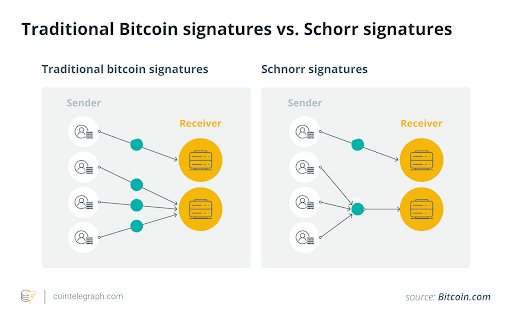In November 2021, Bitcoin received its most important update since Segregated Witness (SegWit) was activated in 2017—the Bitcoin Taproot upgrade. In June 2021, miners signaled their support for the update with a 90% consensus and it was fully activated as a soft fork at block 709,632.
Taproot was meant to improve Bitcoin’s scalability and streamline the verification process entirely, making it faster and more cost-efficient.
What changed?
The Bitcoin Taproot upgrade allows the network to batch multiple signatures and transactions together, making the verification process faster, more private, and more secure in the long run.
Before Taproot, each transaction on the blockchain was verified individually. Depending on how many people were transacting, this could slow down and congest the entire network—leading to slow confirmation times and higher fees. This was even longer for complex multi-signature (multisig) transactions.
On top of the Elliptic Curve Digital Signature Algorithm (ECDSA), Bitcoin was already using—which created signatures from the private keys of a Bitcoin wallet—the Taproot upgrade incorporated Schnorr signatures, which allows the network to use multiple public keys to sign a sum of signatures.

Schnorr signatures were created by German cryptographer Claus Schnorr a long time before Bitcoin was created by Satoshi Nakamoto. However, at the time of Bitcoin’s development, Schnorr signatures were protected by a patent, so Nakamoto turned to ECDSA. Since then, the patent has been lifted and is now available to use on Bitcoin.
Why did we need Taproot?
As Bitcoin adoption grows, the more congested the network can become. As we mentioned earlier, this sometimes led to longer confirmation times and higher fees. Taproot is the long-awaited solution to this problem. Here are some of its advantages:
- More space on the network
The Bitcoin Taproot upgrade allows collaborating parties to transact with a single signature, bringing faster speeds at lower fees. Additionally, since there’s more space on the network, Taproot opens the door for improved layer 1 scalability, increasing the number of transactions a block can take. - Greater security
Schnorr signatures, in nature, are linear—which means more security than ECDSA. They’re also non-malleable and more resistant to spam attacks. - Enhanced privacy
Because of Schnorr signatures, single-signature and multi-signature transactions will have less distinction between them, making it more difficult to identify and monitor each person’s transactions. - Smart contracts
Taproot encourages the use of smart contracts in Bitcoin, opening the door for more decentralized finance (DeFi) opportunities and eliminating the need for any intermediaries. Additionally, smart contracts won’t occupy as much space on the blockchain as they previously did—making them smaller and, in turn, cheaper. - Taro Protocol
Taproot Asset Representation Overlay (Taro) is a Taproot-powered protocol that allows assets like non-fungible assets or collectibles to be issued on the Bitcoin blockchain and enables private and secure transactions via Lightning without bloating the entire network.
How Taproot affects the Lightning Network
When you use the Lightning Network, a private channel is created between you and another user, allowing both of you to transact as much as you want within that channel. However, when you’re done, you’ll still need to close and publish the channel on the main blockchain. Sometimes, doing so can congest the network and slow everything down.
The Bitcoin Taproot upgrade, with its ability to batch transactions together and verify them all at once, will make this process even more efficient. This update will directly affect the functionality and cost-effectiveness of the entire Lightning Network—not only will it become cheaper and more private for all users, but it will also become more flexible for developers who want to build on it.
The long-awaited solution
Instead of flashy new features that grab headlines, the Bitcoin Taproot upgrade is a technical one—fortifying the foundations of Bitcoin and making it easier for everyone to use. Although most wouldn’t even notice that it happened, its potential effects on Bitcoin, in general, are highly significant.
With streamlined transaction processing, easier and faster confirmations on the Bitcoin network, and enhanced security and privacy, it’s safe to say that Taproot is a huge milestone in Bitcoin’s history.